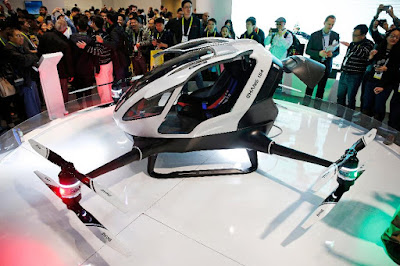 |
| The EHang 184 autonomous aerial vehicle, which was unveiled at the 2016 Consumer Electronics Show, promises to fit a human passenger. (Photo: John Locher/AP) |
On Wednesday, a little-known Chinese drone manufacturer decided to make a splash at Las Vegas’ Consumer Electronics Show. Shooting for headlines, Guangzhou-based EHang unveiled its EHang 184, a passenger-carrying craft that the company dubbed “the world’s first electric, personal Autonomous Aerial Vehicle.”
“EHang 184 is the safest, smartest and eco-friendly low-altitude, Autonomous Aerial Vehicle aiming on providing medium-short transportation solution[s],” said a narrator on the vehicle’s launch video, which showed a human-sized, egg-shaped capsule with four arms and eight propellers gliding majestically over snowcapped mountains, Yosemite’s Hetch Hetchy Valley and the San Francisco skyline.
There was one small issue, however. None of it was real.
“The footage of the drone flying over cities, etc. is computer-generated,” wrote a company spokesperson to FORBES in an email.
While history has no shortage of entrepreneurs who have over-promised on inventions to encourage imagination and build publicity, unrealistic hype has become an all-too-common marketing strategy in the consumer drone industry. Some companies have revealed too much, too soon, sometimes raising money or selling pre-orders on devices that become seriously delayed, or worse, terminated.
Read More: Forbes
(adsbygoogle = window.adsbygoogle || []).push({});

